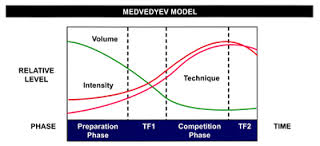Part 1: An Intro to Periodization - Seeing the Bigger Picture
Triathlete Strength Training PrimerPart 1: An Intro to Periodization – Seeing the Bigger Picture
Last week, I wrote about how strength training can benefit the endurance athlete and why you would be remiss to skip a lifting session. Fortunately for me, my readers were paying attention and have been thoroughly convinced that weight training will indeed make them better endurance athletes. Now that we’re ready to attack the weight room, let’s use the next couple of weeks to take a step back and see how we should approach our training and, more importantly, how it changes throughout the year. I will be focusing strictly on the triathlete for this series, but the concepts can be applied to any and all athletes.
Periodization. What is periodization? According to the National Strength and Conditioning Association (NSCA), periodization is defined as preplanned, systematic variations in training specificity, intensity and volume, organized in periods or cycles within an overall program. In other words, we manipulate the exercises we’re training, the percentage of our 1RM that we are training with, and the set/rep scheme we are using based on the time of year when planning a comprehensive training plan. We organize training in this manner to ensure we’re doing all we can to create a program that encourages long-term athletic development and success, while minimizing the risk of injury and overtraining.
Leo Matveyev, a Russian physiologist, is recognized as one the father’s of periodization and his work has been modified throughout the years by various exercise scientists for different populations. The conventional periodization model that strength coaches use is a variation of Matveyev’s model, and it separates training into distinct periods: the preparatory period, first transition period, competition period, and second transition period. Each period presents an opportunity to train different performance qualities and will be briefly defined below.
1) The Preparatory Period: This phase is typically the longest, and occurs during the time of year when there are no scheduled competitive events and minimal sport-specific training sessions. The primary emphasis is on building a base level of conditioning and strength with general exercise selection in preparation for more intense training and the rigors of the competitive season. This can be referred to as the athlete’s “Off-Season.”
2) The First Transition Period: This phase occurs immediately following the end of the Preparatory Period, and emphasizes the switch from high-volume to high-intensity training. The exercises become increasingly sport-specific and technique becomes a major focus. This can be considered the athlete’s “Pre-Season.”
3) The Competition Period: This phase follows the First Transition Period, and our focus is solely on peaking the athlete’s strength, power, and performance for competition. Our athlete is “In-Season” during this time.
4) The Second Transition Period: This phase can be referred to as our “Active Rest” phase, and should last long enough to allow the athlete to completely recover from the competitive in-season. We want to encourage non-sport-specific recreational activities performed at low intensities during this time. It’s important to avoid intense training during this period to allow complete physical and mental recuperation.
Having this basic knowledge of periodization is incredibly important for maintaining long-term success. It’s critical to understand the bigger picture when it comes to our training, so that we can take a more intelligent approach to developing our athletic performance.
That’s all for today’s post, but stay tuned for Part 2 which will be up on the blog next Thursday (10/16). We'll be discussing the Repetition Maximum Continuum, and how we train to enhance performance attributes, not for subjective visual purposes (ex: to tone or lengthen muscle). This post will be absolutely vital in order to properly grasp training methods throughout the competitive year.
The Triathlete Strength Training Primer
Part 1: An Intro to Periodization - Seeing the Bigger Picture Part 2: The Repetition Maximum Continuum Part 3: The Preparatory Period a.ka. the Off-Season Part 4: Off-Season Periodization Part 5: Off-Season Periodization, cont. Part 6: The First Transition Period Part 7: The First Transition Period, cont. Part 8: The Competition Period - In-Season Strength Training Part 9: In-Season Template Part 10: Post- Season Training

